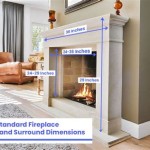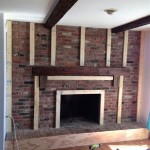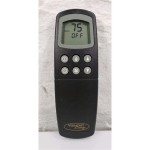Fireplace Gas Inserts: A Comprehensive Guide
Fireplace gas inserts represent a convenient and efficient alternative to traditional wood-burning fireplaces. They offer the aesthetic appeal of a flame without the mess and maintenance associated with wood. These units are designed to fit directly into existing masonry or prefabricated fireplaces, transforming them into a source of clean and controllable heat. This article provides a comprehensive overview of fireplace gas inserts, covering their types, benefits, installation, maintenance, and considerations for choosing the right model.
Types of Fireplace Gas Inserts
Fireplace gas inserts are broadly categorized based on their venting systems and fuel type. Understanding these distinctions is crucial for selecting the appropriate insert for a particular home and fireplace setup.
Direct Vent Inserts: These are the most popular and efficient type of gas insert. They utilize a sealed combustion system, drawing air from outside the home for combustion and venting exhaust gases directly outdoors through a dual-pipe system. This system typically runs horizontally through an existing chimney or wall. Because they do not rely on indoor air for combustion, direct vent inserts minimize heat loss and prevent the drafting of cold air. This sealed system also enhances safety by preventing carbon monoxide from entering the living space.
Vent-Free (Ventless) Inserts: Vent-free inserts, also known as ventless inserts, do not require a chimney or venting system. They burn propane or natural gas very cleanly, theoretically producing minimal exhaust. However, they release combustion byproducts, including water vapor and small amounts of carbon dioxide and carbon monoxide, directly into the home. For this reason, vent-free inserts are subject to strict regulations and often have oxygen depletion sensors that shut off the unit if oxygen levels in the room become too low. Many jurisdictions restrict or prohibit the use of vent-free inserts, and their use is generally discouraged due to potential health concerns associated with indoor air quality. Proper sizing and ensuring adequate ventilation in the room are crucial, if they are permitted.
B-Vent Inserts: B-vent inserts, or natural vent inserts, use the existing chimney to vent exhaust gases. They draw combustion air from the room, making them less efficient than direct vent models. B-vent inserts are more susceptible to drafts and may require chimney relining to ensure proper venting. They are typically less expensive than direct vent inserts but can be more costly to operate due to energy loss. B-vent inserts are becoming less common as direct vent technology improves.
Fuel Type (Natural Gas vs. Propane): Fireplace gas inserts operate on either natural gas or propane. Natural gas is generally more affordable if a home has an existing natural gas line. Propane, delivered in tanks, offers greater flexibility in terms of location, as it does not require connection to a municipal gas line. However, the cost of propane can fluctuate, and homeowners need to manage propane tank refills. Conversion kits are sometimes available to switch a gas insert from one fuel type to another, but this should be done by a qualified technician.
Benefits of Fireplace Gas Inserts
Gas inserts offer several advantages over traditional wood-burning fireplaces and other heating options. These benefits contribute to their increasing popularity among homeowners.
Efficiency and Heat Output: Gas inserts are significantly more efficient than open-hearth wood-burning fireplaces, which can lose a large percentage of heat through the chimney. Direct vent inserts, in particular, can achieve efficiency ratings of 70-85% or higher, meaning that a greater proportion of the fuel is converted into usable heat. This results in lower heating costs and a more comfortable living environment. The heat output of a gas insert is measured in British Thermal Units (BTUs), and models are available with varying BTU ratings to accommodate different room sizes and heating needs.
Convenience and Ease of Use: Unlike wood-burning fireplaces, gas inserts require no wood chopping, stacking, or hauling. They ignite with the push of a button or the flip of a switch, and the flame height and heat output can be easily adjusted using a thermostat or remote control. This level of control allows homeowners to maintain a consistent temperature in their homes without the constant monitoring required for a wood fire. Gas inserts also eliminate the mess associated with wood ash and soot.
Safety: Gas inserts are generally safer than wood-burning fireplaces. Direct vent models have sealed combustion systems, which prevent carbon monoxide from entering the home. They also eliminate the risk of flying sparks and embers, which can be a fire hazard with wood fires. Many gas inserts have safety features such as oxygen depletion sensors and automatic shut-off mechanisms. However, it is crucial to have gas inserts professionally installed and regularly inspected to ensure safe operation.
Aesthetics: Gas inserts offer a variety of aesthetic options to complement different home decor styles. They are available with realistic-looking artificial logs, decorative glass, and various flame patterns. Some models even feature ambient lighting to enhance the visual appeal. The ability to customize the appearance of a gas insert allows homeowners to create a focal point in their living space that is both functional and aesthetically pleasing.
Environmental Considerations: Gas inserts burn cleaner than wood-burning fireplaces, producing fewer emissions and contributing less to air pollution. This is especially important in areas with air quality concerns. While natural gas and propane are fossil fuels, their combustion produces lower levels of particulate matter and other pollutants compared to wood. Choosing a high-efficiency gas insert can further reduce environmental impact.
Installation and Maintenance
Proper installation and maintenance are essential for the safe and efficient operation of a fireplace gas insert. These tasks should be performed by qualified professionals to ensure compliance with safety codes and manufacturer recommendations.
Installation: Gas insert installation typically involves several steps, including preparing the existing fireplace, running gas lines, installing venting systems (if applicable), and connecting the insert to the gas supply. A licensed gas fitter or HVAC technician should perform this work to ensure that all connections are leak-free and that the insert is properly vented. Incorrect installation can lead to gas leaks, carbon monoxide poisoning, or fire hazards. Local building codes and regulations must be followed during the installation process.
Annual Inspection and Cleaning: Regular maintenance is crucial for maintaining the efficiency and safety of a gas insert. An annual inspection by a qualified technician should include checking the gas lines for leaks, cleaning the burner assembly, inspecting the venting system, and testing the safety features. The glass front of the insert should be cleaned regularly to remove soot and deposits, which can reduce visibility. The area around the insert should be kept clear of flammable materials.
Troubleshooting: Common issues with gas inserts include pilot light problems, flame issues, and gas leaks. If the pilot light goes out, follow the manufacturer's instructions for relighting it. If the flame is weak or uneven, the burner assembly may need cleaning or adjustment. Suspected gas leaks should be reported to the gas company or a qualified technician immediately. Do not attempt to repair gas inserts yourself unless you are a qualified professional.
Chimney Inspection and Cleaning: For B-vent inserts, the chimney should be inspected and cleaned regularly to ensure proper drafting. Creosote buildup in the chimney can create a fire hazard. A professional chimney sweep can remove creosote and other debris to maintain a safe and efficient venting system.
Choosing a fireplace gas insert requires careful consideration of several factors, including the size and layout of the room, the type of existing fireplace, the desired heat output, and aesthetic preferences. Consulting with a qualified professional can help homeowners make an informed decision and select the right model for their needs.
When determining the appropriate BTU rating for a gas insert, consider the size of the room to be heated, the insulation levels in the home, and the climate. A larger room or a poorly insulated home will require a gas insert with a higher BTU rating. It is important to choose a gas insert that is appropriately sized for the space to avoid overheating or underheating. Some models have variable BTU output, allowing for greater control over the heat level.
Exploring the various aesthetic options available is an important part of selecting a gas insert. Artificial logs are available in a variety of styles and materials, mimicking the appearance of natural wood. Decorative glass options include clear glass, tinted glass, and reflective glass. The flame pattern can also be customized, with options such as traditional flames, ribbon flames, and multi-sided flames. Consider the overall decor of the room and choose a gas insert that complements the existing style.
Prior to purchasing any gas appliance, it is imperative to have the unit professionally installed by a licensed technician. An improperly installed gas appliance poses a substantial risk of gas leak and carbon monoxide poisoning. Ensure the installer holds appropriate certifications and has extensive experience with gas insert installations.

Gas Fireplace Inserts Napoleon Fireplaces

Belmont Small Gas Insert

Nfi Certified Gas Fireplace Insert Installations Buffalo Rochester Ny

Short Pump Va Fireplaces Stoves Gas Inserts Wood

Gas Fireplace Inserts Modern Burning Fort Collins Fireplaces

Majestic 25 Inch Ruby Direct Vent Gas Fireplace Insert

Gas Fireplaces Inserts And Stoves N Fixin S
.aspx?strip=all)
Top 11 Gas Fireplace Insert Trends Of 2024

Rustic Gas Fireplace Inserts Kozy Heat

Enviro E Series Gas Or Propane Insert Fireplace Fireplaces By Cameron








